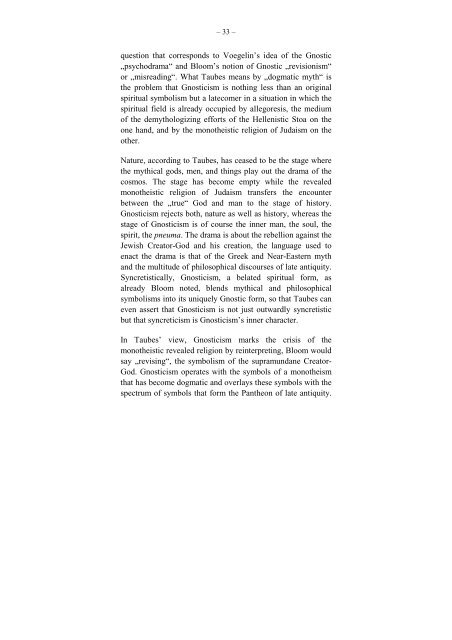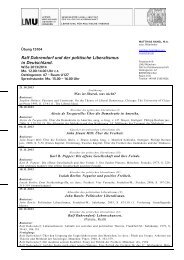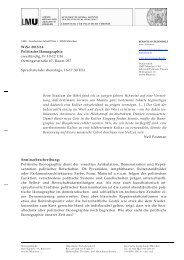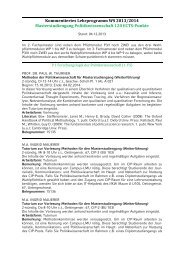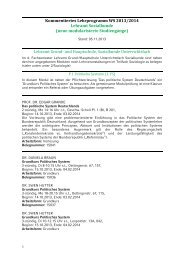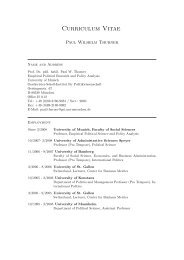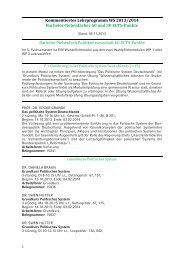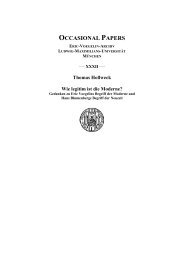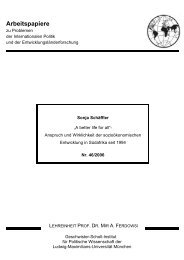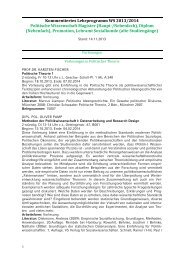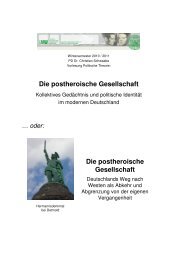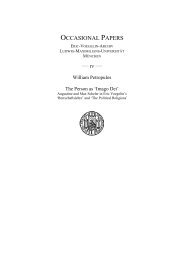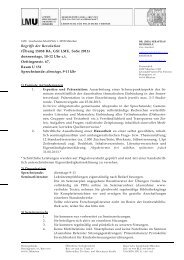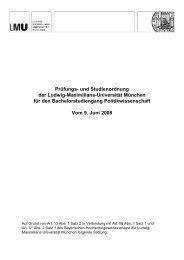THOMAS HOLLWECK is Associate Professor of German at
THOMAS HOLLWECK is Associate Professor of German at
THOMAS HOLLWECK is Associate Professor of German at
You also want an ePaper? Increase the reach of your titles
YUMPU automatically turns print PDFs into web optimized ePapers that Google loves.
– 33 –<br />
question th<strong>at</strong> corresponds to Voegelin’s idea <strong>of</strong> the Gnostic<br />
„psychodrama“ and Bloom’s notion <strong>of</strong> Gnostic „rev<strong>is</strong>ion<strong>is</strong>m“<br />
or „m<strong>is</strong>reading“. Wh<strong>at</strong> Taubes means by „dogm<strong>at</strong>ic myth“ <strong>is</strong><br />
the problem th<strong>at</strong> Gnostic<strong>is</strong>m <strong>is</strong> nothing less than an original<br />
spiritual symbol<strong>is</strong>m but a l<strong>at</strong>ecomer in a situ<strong>at</strong>ion in which the<br />
spiritual field <strong>is</strong> already occupied by allegores<strong>is</strong>, the medium<br />
<strong>of</strong> the demythologizing efforts <strong>of</strong> the Hellen<strong>is</strong>tic Stoa on the<br />
one hand, and by the monothe<strong>is</strong>tic religion <strong>of</strong> Juda<strong>is</strong>m on the<br />
other.<br />
N<strong>at</strong>ure, according to Taubes, has ceased to be the stage where<br />
the mythical gods, men, and things play out the drama <strong>of</strong> the<br />
cosmos. The stage has become empty while the revealed<br />
monothe<strong>is</strong>tic religion <strong>of</strong> Juda<strong>is</strong>m transfers the encounter<br />
between the „true“ God and man to the stage <strong>of</strong> h<strong>is</strong>tory.<br />
Gnostic<strong>is</strong>m rejects both, n<strong>at</strong>ure as well as h<strong>is</strong>tory, whereas the<br />
stage <strong>of</strong> Gnostic<strong>is</strong>m <strong>is</strong> <strong>of</strong> course the inner man, the soul, the<br />
spirit, the pneuma. The drama <strong>is</strong> about the rebellion against the<br />
Jew<strong>is</strong>h Cre<strong>at</strong>or-God and h<strong>is</strong> cre<strong>at</strong>ion, the language used to<br />
enact the drama <strong>is</strong> th<strong>at</strong> <strong>of</strong> the Greek and Near-Eastern myth<br />
and the multitude <strong>of</strong> philosophical d<strong>is</strong>courses <strong>of</strong> l<strong>at</strong>e antiquity.<br />
Syncret<strong>is</strong>tically, Gnostic<strong>is</strong>m, a bel<strong>at</strong>ed spiritual form, as<br />
already Bloom noted, blends mythical and philosophical<br />
symbol<strong>is</strong>ms into its uniquely Gnostic form, so th<strong>at</strong> Taubes can<br />
even assert th<strong>at</strong> Gnostic<strong>is</strong>m <strong>is</strong> not just outwardly syncret<strong>is</strong>tic<br />
but th<strong>at</strong> syncretic<strong>is</strong>m <strong>is</strong> Gnostic<strong>is</strong>m’s inner character.<br />
In Taubes’ view, Gnostic<strong>is</strong>m marks the cr<strong>is</strong><strong>is</strong> <strong>of</strong> the<br />
monothe<strong>is</strong>tic revealed religion by reinterpreting, Bloom would<br />
say „rev<strong>is</strong>ing“, the symbol<strong>is</strong>m <strong>of</strong> the supramundane Cre<strong>at</strong>or-<br />
God. Gnostic<strong>is</strong>m oper<strong>at</strong>es with the symbols <strong>of</strong> a monothe<strong>is</strong>m<br />
th<strong>at</strong> has become dogm<strong>at</strong>ic and overlays these symbols with the<br />
spectrum <strong>of</strong> symbols th<strong>at</strong> form the Pantheon <strong>of</strong> l<strong>at</strong>e antiquity.


